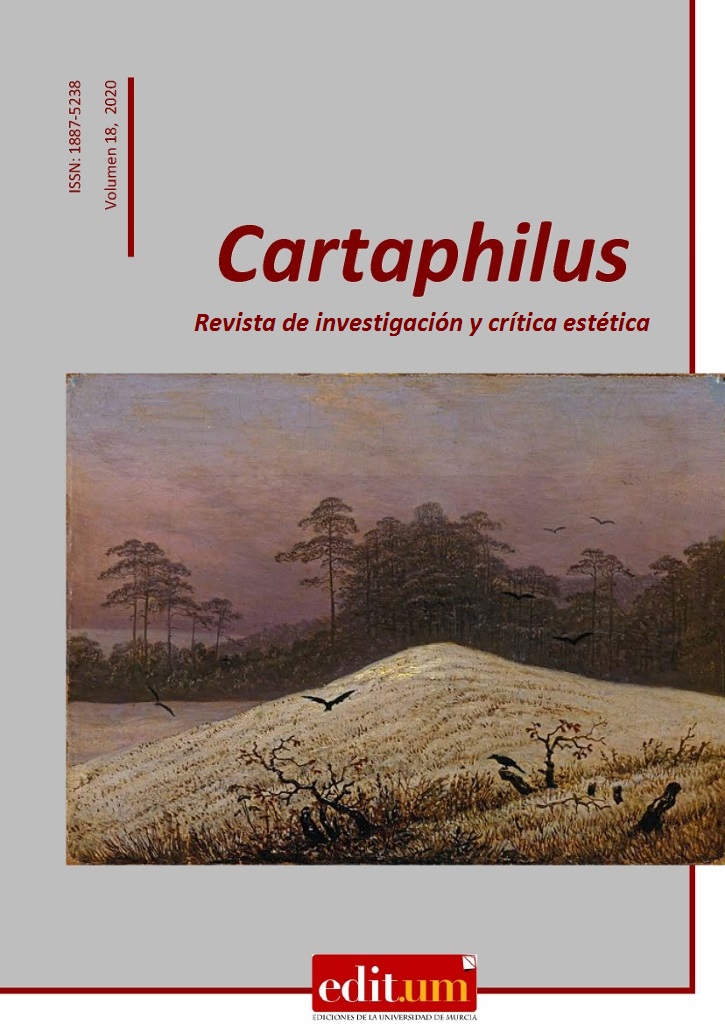John Cage’s japanese garden: Ryoanji or the destruction of the ego
Abstract
In 1962 John Cage travelled to Japan, where he visited Ryoanji’s famous Zen garden in Kyoto. There arises a keen interest in the celebrated garden, thus building a lifelong relationship based on mutual influence. The creative significance of such a connection has been widely discussed in the fields of art and music. However, it also urgently needs to be analyzed from an aesthetic-ontological perspective, focused particularly on the destruction of the ego as a basis for the psychological development of “I”. In this context, the present paper argues that Cage’s fascination for Ryoanji goes well beyond mere aesthetic affinities or methodological principles, such as chance and automatism. More specifically, it takes root in the dissolution of the ‘I’.
Downloads
-
Abstract1081
-
pdf (Español (España))715
References
Bibliografía:
Bernstein, David W. y Hatch, Christopher (ed.) (2001). Writings through John Cage Music, Poetry, and Art. Chicago, London: The University of Chicago Press.
Brown, Kathan (2000). John Cage Visual Art: To Sober and Quiet the Mind. San Francisco: Crown Point Press.
Cage, John (1967). A Year from Monday. New Lectures and Writings. Middletown, Connecticut: Wesleyan University Press.
------------------ (1969). Notations. New York: Something Else Press.
------------------ (1981). Empty Words. Middletown, Connecticut: Wesleyan University Press.
------------------ (1999). Escritos al oído. Murcia: Colegio Oficial de Aparejadores y Arquitectos Técnicos de Murcia.
------------------ (2002). Silencio. Madrid: Árdora Ediciones.
Clancy, Judith (2014): Kyoto Gardens: Masterworks of the Japanese Gardener’s Art. Tokyo, Rutland, Vermont, Singapore: Tuttle Publishing.
Deutsch, Eliot (1975). Studies in Comparative Aesthetics. Monographs of the Society for Asian and Comparative Philosophy, n. 2, Honolulu: University Press of Hawaii.
Dickinson, Peter (ed.) (2006). CageTalk: Dialogues with and about John Cage. New York: University of Rochester Press.
Fowler, Michael (2014). Sound Worlds of Japanese Gardens. An Interdisciplinary Approach to Spatial Thinking. Bielefeld: Transcript Verlag.
Gann, Kyle (2010). No Such Thing as Silence. John Cage’s 4’3’’. New Haven, London: Yale University.
García Gutiérrez, Fernando (1998). El zen y el arte japonés. Sevilla: Guadalquivir Ediciones.
González Vallés, Jesús (2014). Historia de la Filosofía japonesa. Madrid: Tecnos.
Inaji, Tashiro (1998). The Garden as Architecture. Form and Spirit in the Gardens of Japan, China, and Korea. Tokyo, New York, London: Kodansha International.
Izutsu, Toshihiko (2009). Hacia una filosofía del budismo zen. Madrid: Trotta.
Jaeger, Peter (2013). John Cage and Buddhist Ecopoetics. London, New Delhi, New York, Sydney: Bloomsbury.
Keane, Marc Peter (2002). The art of setting stones & other writings from the Japanese garden. Berkeley, California: Stone Bridge Press.
Larson, Kay (2012). Where the Heart Beats: John Cage, Zen Buddhism, and the Inner Life of Artists. New York: Penguin Press.
Mansfield, Stephen (2009). Japanese Stone Gardens: Origins, Meaning, Form. Tokyo, Rutland, Vermont, Singapore: Tuttle Publishing.
Martínez García-Posada, Ángel (2017). Entre piedras y lugares. Traslaciones, cartografías, figuraciones y abstracciones. Revista Europea de Investigación en Arquitectura, n. 9, pp. 66-81.
Mehta, Geeta K. (2008). Japanese Gardens: Tranquility, Simplicity, Harmony. Tokyo, Rutland, Vermont, Singapore: Tuttle Publishing.
Nicholls, David (2009). John Cage. Madrid: Turner Música.
Nicholls, David y Cross, Jonathan (ed.) (2002). The Cambridge Companion to John Cage. Cambridge: Cambridge University Press.
Nitschke, Günter (2003). El jardín japonés. Köln, London, Los Angeles, Madrid, Paris, Tokyo: Taschen.
Retallack, Joan (ed.) (1996). Musicage. John Cage in Conversation with Joan Retallack. Cages muses on words, art and music. Middletown, Connecticut: Wesleyan University Press.
Schlüter Rodés, Ana María y González Faus, José Ignacio (1998). Mística oriental y mística cristiana. Santander: Sal Terrae.
Shultis, Christopher (1995). Silencing the Sounded Self: John Cage and the Intentionality of Nonintention. The Musical Quarterly, vol. 79, n. 2, pp. 312-350.
Suzuki, Daisetsu Teitaro (2006). ¿Qué es el zen? Madrid: Losada.
Thierolf, Corinna (ed.) (2013). John Cage: Ryoanji. Catalogue Raisonné of the Visual Artworks, Vol. I. Munich: Schirmer/Mosel, Pinakothek der Moderne.
Vega Esquerra, Amador (2002). Zen, mística y abstracción. Ensayos sobre el nihilismo religioso. Madrid: Trotta.
Vives, Javier (2010). El teatro japonés y las artes plásticas. Gijón: Satori.
------------------ (2014). Historia y arte del jardín japonés. Gijón: Satori.
Watts, Alan (2010). El camino del Zen. Barcelona: Edhasa.
Whittington, Stephen (2013). Digging in John Cage’s Garden: Cage and Ryōanji. Malaysian Music Journal, vol. 2, n. 2, pp. 12-21.
Wilson, William Scott (2012). The One Taste of Truth: Zen and the Art of Drinking Tea. Boston, Massachusetts: Shambhala Publications.
Works published in this journal are subject to the following terms:
1. The Servicio de Publicaciones of the University of Murcia (the publisher) reserves the copyright of the published works and encourages and allows their reuse under the usage licence indicated in point
© Servicio de Publicaciones, Universidad de Murcia, 2015
2. Works are published in the electronic edition of the journal under a Creative Commons Reconocimiento-NoComercial-SinObraDerivada 4.0 International licence (legal text). They may be copied, used, disseminated, transmitted and publicly displayed, on condition that: i) the author and original source of the publication are cited (journal, publisher and URL of the work); ii) the material is not used for commercial purposes; iii) the existence and specifications of this licence for use are mentioned.

3. Self-archiving conditions We allow and encourage authors to electronically disseminate the preprint versions (the pre-review version) and/or post print (the version that has been reviewed and accepted for publication) of their works before they are published as this encourages earlier circulation and dissemination and so a potential increase in their citation and impact in the academic community.




